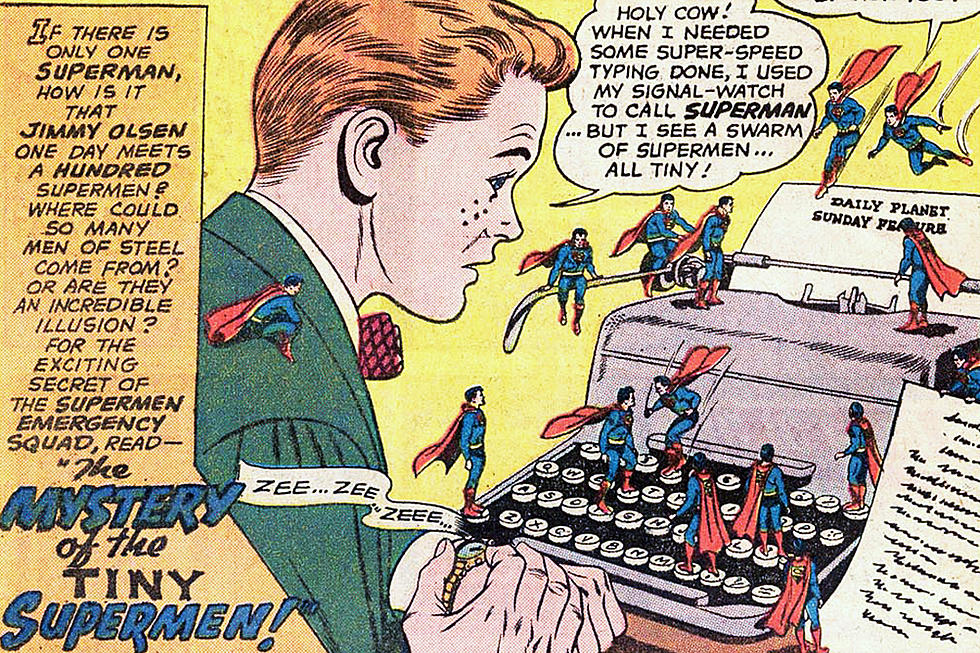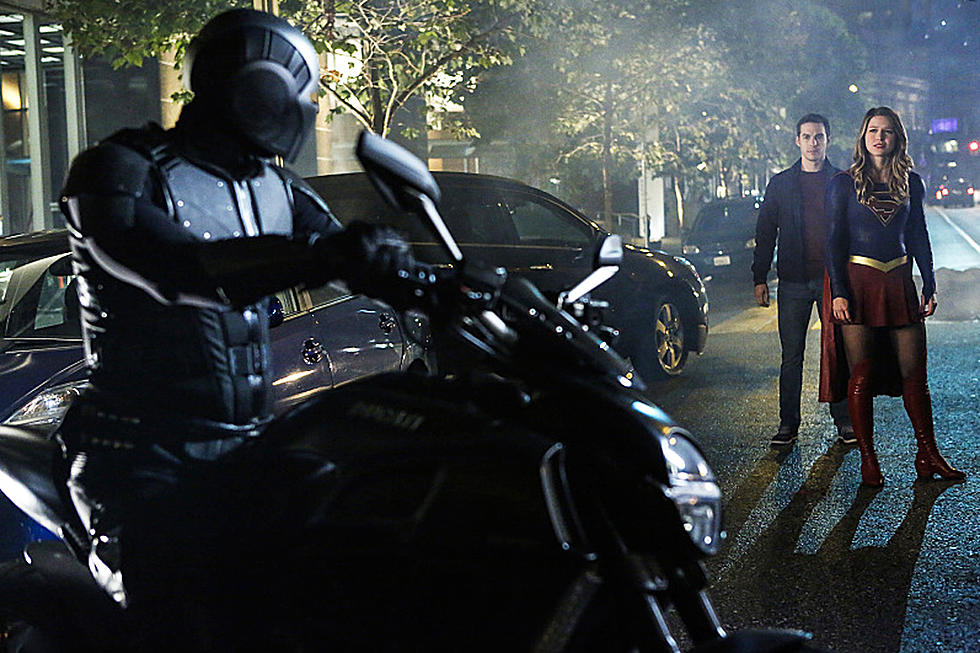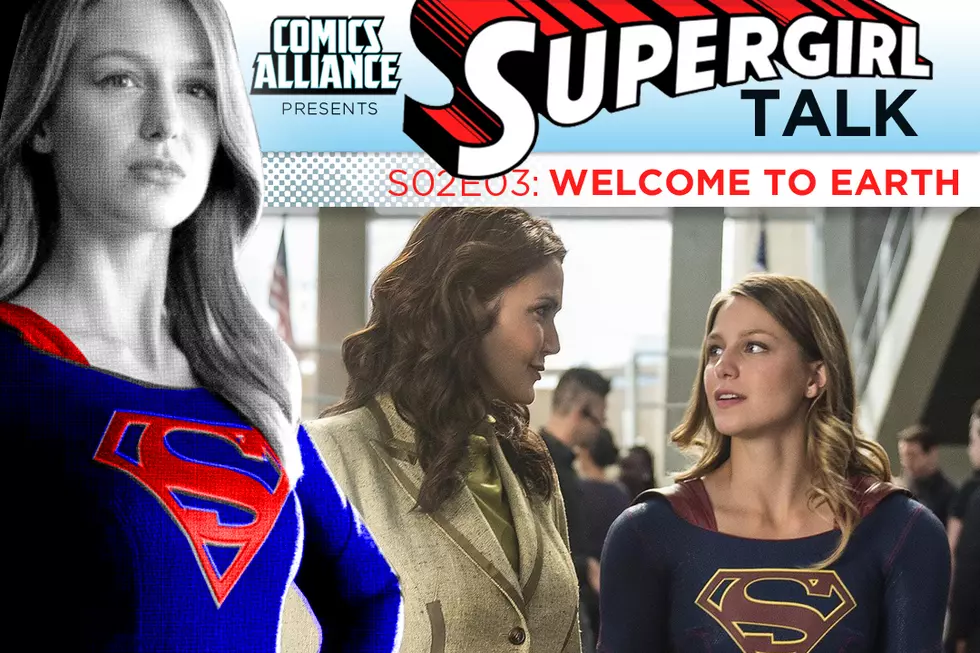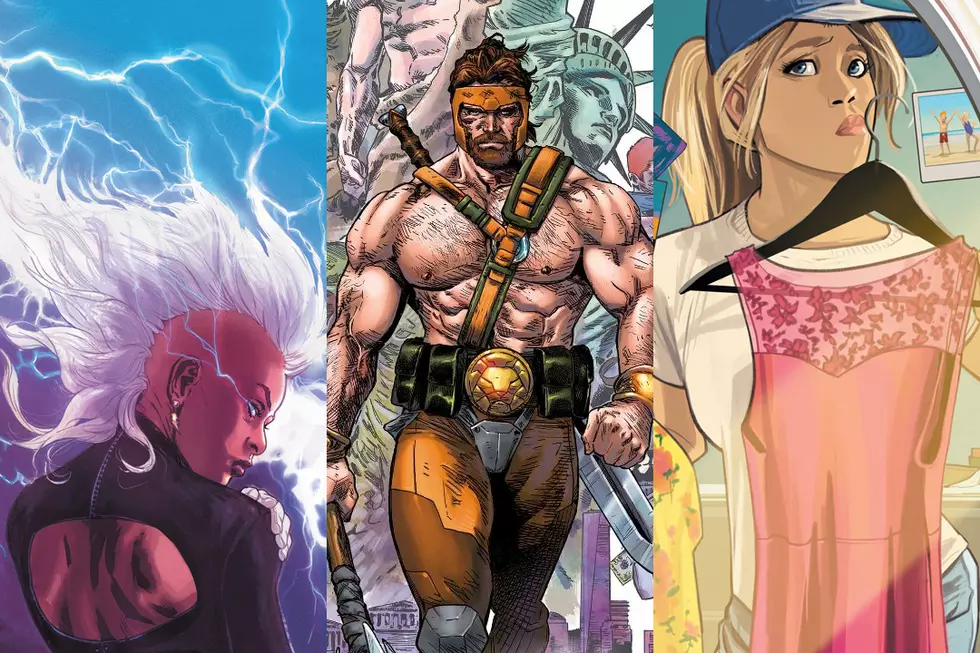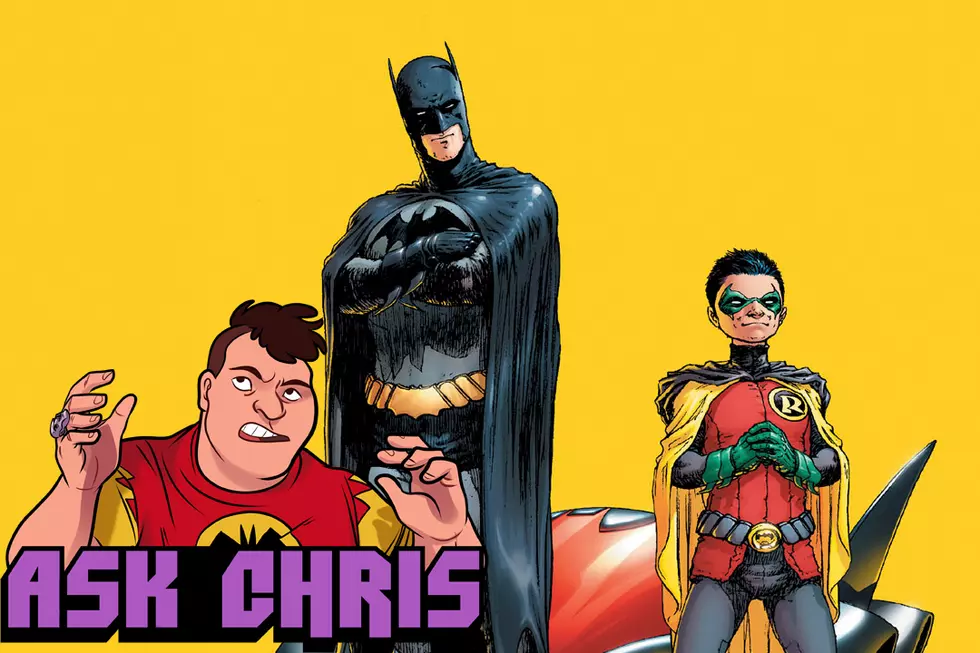
ComicsAlliance’s Top 10 Best Comics of 2010

It's not just that they're doing Jimmy Olsen stories, either. Putting Modern Age spotlight onto Superman's Pal has been done a few times over the years since Crisis On Infinite Earths demoted him from "Superman's sidekick" to "extremely minor character that we'll probably kill off in a crossover," but none of them have had the same ring as what's going on here. I imagine it has a lot to do with the fact that there haven't been any books for Jimmy to take a lead role -- which makes me worry now that we know DC's cutting out their backups in favor of a thinner page count at a lower price -- but more than that, it's because nobody's been able to do what Spencer and Silva have. They're not just wallowing in nostalgia, they're taking the core idea, the notion that a normal guy can be cool enough to succeed in impossibly insane situations that arise from life in a super-hero universe, and doing it with an honesty and charisma that make it one of the stories I'm most looking forward to every month.
 Alien celebutantes who get drunk on oxygen and party so hard that it destroys the planet, a junior LexCorp exec to rival Jimmy in the way that Lex Luthor rivals Superman that almost veers into farce (in a good way) and a seven-day mission to get the Daily Planetthe best story he can, they're all great story elements that show both a love of the character and a knowledge of what will drive the most fun story. Plus, they managed to not just include Chloe Sullivan, transplanting her from Smallville to the comic page as the ex-girlfriend Jimmy wants to win back, but she's actually really good
Alien celebutantes who get drunk on oxygen and party so hard that it destroys the planet, a junior LexCorp exec to rival Jimmy in the way that Lex Luthor rivals Superman that almost veers into farce (in a good way) and a seven-day mission to get the Daily Planetthe best story he can, they're all great story elements that show both a love of the character and a knowledge of what will drive the most fun story. Plus, they managed to not just include Chloe Sullivan, transplanting her from Smallville to the comic page as the ex-girlfriend Jimmy wants to win back, but she's actually really good
Action Comics has had a pretty great year with Paul Cornell bringing robot Lois Lanes, Mr. Mind Jr. and a city of traps built by Vandal Savage to the forefront of comics, but it's Spencer and Silva in the backup stories that really show DC's ready to have some fun again.
-Chris Sims
9. Joe the Barbarian

I don't remember seeing too much talk about Joe the Barbarian once it actually came out. I haven't really talked about it. There was lots of anticipation for it, murmurs of excitement, before it started coming out, but since issue #1 dropped in January... I think the last time it was discussed directly on this blog was back in March, with issue #3. In other venues? Well, Jog the Blog and Tom Spurgeon put it on their notable new release lists a few times. I think there might have been a piece on the Journal's website. Anybody else? Anybody? Bueller?
The book doesn't seem to invite extreme reactions, or at least not high-pitched ones, but I've loved this book. It's been my can't-wait-to-read book all year -- every time an issue comes out it's the shiniest, prettiest, most irresistible thing in my new releases pile, and I grab it before anything else, and usually read it twice. But even so, I'm not moved to shout from the hilltops. There aren't any "whaaaaaat" moments. I don't drop the book in disbelief with my jaw hanging open, while angels Hammer-dance back and forth over my head, high-fiving as they pass each other. Something else happens with Joe the Barbarian, something rarer: I'm drawn in.
The bare plot of Joe is straightforward: Joe is a kid, early teenager-ish but still young, who is meekly overwhelmed by his outcast status, his father's death in Iraq, his mother's struggle to keep their house, and his Type 1 diabetes. It's the last one that serves as the engine for most of the series, as Joe goes into hypoglycemic shock, which his brain and the comic interpret as a hallucinatory epic struggle between good and evil in a fantasy world made up of Joe's preoccupations: his toys and comic books vs. the crushing stresses of his real-world life.
A lot of the book is straight dream-fantasy of the "Wizard of Oz" variety, but remember that scene near the beginning of "The Wizard of Oz," where Judy Garland is balance-beaming along the edge of the pig pen, and falls in? Everyone freaks out, because pigs, to quote the English guy with glasses from Snatch, will "go through bone like butter." Dorothy is about to get eaten by the animals on her own family's farm. Look, Margaret Hamilton was pretty scary, but that is downright TERRIFYING. All the other kids were afraid of the flying monkeys, but I was afraid of the pigs, and I think this helps explain what I find so engrossing about Joe the Barbarian. Unlike "The Wizard of Oz," the fantasy and reality portions of Joe aren't segregated. They bleed into each other.

In "real life," Joe is trying to make it downstairs to the fridge, to get a soda, to restore his glucose levels and reconnect with reality. But he gets confused, side-tracked into the "fantasy world," where his pet mouse is a broadsword-wielding warrior and the girl he likes at school is a spunky inventor. The geography of his house is coded as the landscape of a fantasy novel, and actions and events in both realities echo in the other with dreamlike unease. The comic spends a lot of time in the fantasy world, but the whole time, I'm holding my breath for the real world scenes. I'm waiting to see where he's ended up in the house, and whether he's fantasied himself right into the pig pen. As it stands at the end of penultimate issue #7, it sure looks like he has.
Which brings us to another thing: Joe the Barbarian isn't over yet -- as of this writing, issue #8, the last issue, has yet to hit stores -- but I'm 100% comfortable putting it on a Best of the Year list. Do I want to know how it ends? Desperately. Will the ending likely cast a lot of the book in a different light and allow me to tease out greater or more layered meaning from moments throughout the story? Undoubtedly. I want to read more into Joe's mom blaming their life struggles on his dead father. I want to have the upside-down motif reach some sort of climax that resonates back through each moment it's come up in the story. I want to see if this is another fiction-as-corrective story from Morrison (a la The Filth) or if the story will stick with the more ambiguous take it's offered so far on the relationship between fantasy and reality.
But, ultimately, no matter what happens in #8, I've gotten a year's worth of immersion and joy from the first seven issues, and that isn't going to change. The way Morrison has toned down the rapid-fire bombast of past work without sacrificing the layering of symbolism and metaphor, the way Murphy's art switches from expansive and meditative to frantic and action-packed to dark and foreboding, the way Dave Stewart is just such an amazing colorist -- man, I can't believe how good a colorist that guy is. I've just really been happy to enjoy this as a comic book. To have a new issue come out and get excited. To get lost in the story. That doesn't happen for me that often with comics anymore. So, a place on the Best Of? You betcha. Joe the Barbarian for President!
-Jason Michelitch

"Let us see wonders, Jane."
Thor's invitation to Jane Foster comes at the opening to issue #5 as they set off to explore the Earth together, but I can't help thinking that this one simple sentence exemplifies the entire series. I think as readers, we should retroactively put that line at the opening to Thor: The Mighty Avenger and hear it as an invitation to all of us. Because reading this book is an opportunity to see the world of superheroes with a renewed sense of wonder, something that often gone missing from today's comics.
Roger Langride, Chris Samnee, Matt Wilson and Rus Wooton have collaborated to create a rare gem of a comic, and in their own way managed to subvert the contemporary definition of quality in the superhero genre. Take a look at the rest of the field, and lot of what you'll see these days is gratuitous violence and excessively complex continuity games that can confuse all but the most knowledgeable of fans. Everything is an event or a dramatic shift in the status quo. But Thor: TMA is none of that. There's no issue that claims that nothing will ever be the same, and that's what makes it so great. We don't need to be told that changes are happening, we can see them taking place. The heart of this book is a cast of endearing characters and a thoughtful, clever plot that keeps moving forward in all the right ways. Nothing more, nothing less.
The pure joy of reading this book comes from the interactions between characters as we relationships old and new evolve on the page with the same level of humanity that you might see in real life. This is a book that relies on charm and succeeds completely at it, probably because before it's a story about god and heroes, it's simply a sweet and utterly beautiful love story.
 Of course, this comic is hardly just a romance. Thor is on a personal journey here, and the people he meets along the way, from the Van Dynes to the Warriors Three bring along some of the best blend of action and comedy I've seen in a long time. The entire encounter with Captain Britain in issue #4 is completely hilarious, and later on we get to meet what might be the first likable version of Namor in Marvel history.
Of course, this comic is hardly just a romance. Thor is on a personal journey here, and the people he meets along the way, from the Van Dynes to the Warriors Three bring along some of the best blend of action and comedy I've seen in a long time. The entire encounter with Captain Britain in issue #4 is completely hilarious, and later on we get to meet what might be the first likable version of Namor in Marvel history.
The art in this book is something special, too. It's pretty clear that 2010 has been a banner year for Chris Samnee, but if there's one thing that can be said about his art, it's that it just keeps getting better. Keep in mind that we're talking about a guy who was pretty awesome to start with. And the color palette that Matt Wilson brings to Samnee's art basically makes the whole thing perfect. I've never been the type of person to refer to any comic as perfect, but I've read and reread these books, and that's the only word I can come up with.
I've heard here and there that there were people who refused to pick up this comic because it was billed as an "all ages" book, and it's a shame for them. It's unfortunate aspect of comics culture today, the idea that a book that's been created with everyone in mind can't possibly appeal to adults. But this comic is clearly successful in illustrating that there's a big difference between "mature" content and something for grown-ups. There's more than enough subtle wit in here to entertain the adults among us, and for the kids, this is the kind of comic that will expand their vocabularies while showing them the simple pleasures of a high-quality superhero story.
Marvel's announcement that Thor: TMA would be ending with issue #8 led to an Internet-based outpouring of support for the book from fans. There's a pretty passionate Facebook group going and folks are still tweeting the hashtag #savethorthemightyavenger. Who knows if Marvel will actually respond to the fans in this case, but it would be great if at the very least, they could allow Langridge and Samnee to complete the planned 12 issue arc on the book. After all, Marvel kept Spider-Girl going for years in response to direct demand from loyal fans. With those 12 issues, we could get the complete story, and there's not a doubt in my mind that we're all at a loss if we never get to see that.
We've certainly gotten to see some wonders, though.
-David Wolkin

Brandon Graham's King City is one of those books that makes you love comics even more and make you wish other comics were better. The twelve-issue series follows Joe, a Catmaster, and his cat Earthling, who can perform various actions, like picking locks, cutting everything within a certain radius in two, or parachuting. Joe is a normal guy who left King City after a rough breakup but has finally returned after becoming a Catmaster. He left some time before after a rough breakup. Somewhere in all of this is a creeping evil that might destroy the world.
But, sweep all of that end of the world stuff to the side for a minute. King City is about three things: people, puns, and places. It's such a strong, fantastic work because Graham's characters feel like people you know, or perhaps even like someone you might have been. Everyone is intensely relatable, maybe not in terms of having goofy sci-fi powers, but who can't relate to missing somebody so much your whole body hurts? Or being unhealthily attracted to someone else? Or making what feels like the mistake of your life and rushing to correct it?
The other part of King City is the puns. For example, at one point, a woman holds up a stuffed marmoset toy and, in an attempt to cheer up her man, says, "Marmoset there'd be days like this." It's the cutest thing you'll ever see, and merely the beginning of the puns in King City. Every single page has something worth examining, whether it's a play on words or dirty joke.

Finally, King City is a place, but it's almost a person in and of itself. It's teeming with personality, with rude citizens, ruder buildings, and blocks full of impressive sights. Everything is normal in King City and everything is for sale. If you want it, you can have it. Drugs, knives, and sex? Sure. There's even a guy who has a drug knife you can have sex with.
The city comes off as a tangled amalgamation of everything Graham enjoys in life. There are subtle and overt references to other properties, such as when "Optimus Prime Roast" comes up in one panel partway through the series. That diversity of content and location makes the city feel weird, but real. It's a descendent of every city anyone ever lived in, simultaneously terrifying and comfortable. Danger lurks around every corner, but you shouldn't be afraid, because love does, too. King City is like real life.
-David Brothers

Woodring is a cartoonist of frightening power, and Weathercraft is him performing at full strength, a high note sustained for every panel on 100 pages. His work is of a caliber where it's hard to know what to say about it, so struck dumb are you by the immensity of the rendering and storytelling skill on the page. The dense strangeness of Woodring's world suffocates your rational brain, even as the clarity of his action and compositions pull you forward at an unrelenting pace. Weathercraft rewards equally either a full-speed read-through or a dedicated study of a single panel or sequence.
Weathercraftis wordless, which is appropriate, as its story is difficult to verbalize. Two witches perform strange rites that seem to dictate the events of the story, in which Manhog, a humanoid pig, is beset by horrible tribulations and tortures, resulting in a sort of enlightenment and ennoblement of the creature. His torturer, a moon-faced villain named Whim, transforms into a reality-shattering evil plant-god. Woodring's perennial main character Frank, a little chipmunk guy drawn not totally unlike classic animation characters Mickey Mouse and Felix the Cat, wanders through the book, pursuing idle luxury and comfort at the expense of morality whenever he can.

Woodring's art is like a 1930's cartoon filtered through psychedelic hallucination and primordial dread. Every character is fair game to be bent, twisted, and tortured by either enemies or their environmen, and the very fabric of reality itself is malleable, with stone walls warping, time and place shifting, and holes being torn in the middle of thin air. Everyone and everything seems both dangerous and in danger. There is no comfort zone in Weathercraft. Everything is up in the air, and the unpredictable and omnipresent threat of inscrutable horror creates an exhilarating sense of unease.
The power of Weathercraft is not merely aesthetic, however. The dread and wonder are thick and effective, but there is intellectual substance as well as emotional tone. Working without words, Woodring still delivers a story, and he defines his characters in the best way: through their actions. Manhog, Frank, Whim, and the rest of the supporting cast clearly act according to inner strengths and weaknesses, spurred by their essential character.
Manhog seeks shelter and comfort, until he is evolved through trial, and then seeks knowledge and justice. We watch him transform from scurrying, beleagured, four-legged creature to one that walks on hind legs, dresses in clothes, and shows warmth and empathy to others. Conversely, Frank, who starts out on hind legs and never changes, seeks out luxury and fun, but his face never exhibits joy. His expression is a stone-blank one, except when screaming in fear, or leering in weary insanity.
Frank's character is most clearly defined in the book in a scene in which he sits under at tree, enjoying a lovely picnic, while looking on, slightly curious but ultimately uncaring, at Manhog screaming through the bars of a torture chamber. It is very nearly a political moment, but like every scene in the book, though Woodring's action is clear, the ultimate meanings are open. Without words to define things precisely, we're left with suggestive but ambiguous images that provoke thought and analysis without providing the release of answers.
There is no other comic this year that so successfully creates such a viscerally compelling and hermetically individual fictional world, or which displays such a thorough mastery of visual storytelling, provoking complex thoughts and feelings with simple, beautiful strokes. Weathercraft is essential.
-Jason Michelitch
More From ComicsAlliance




